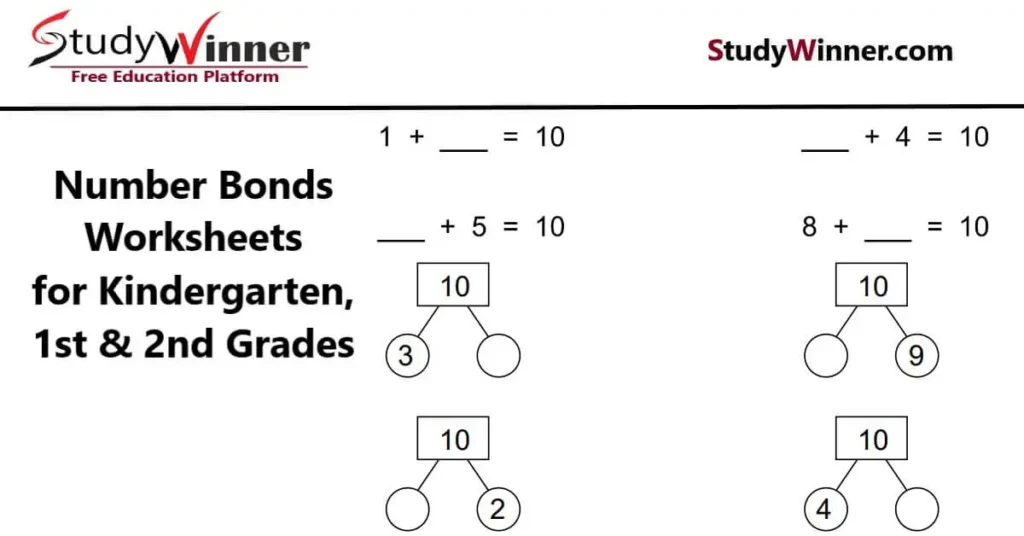Number Bonds Kindergarten Worksheets
Kindergarten and 1st, 2nd grade students can enhance their skills in number counting, addition and subtraction by using these number bonds worksheets. Parents can use this number bond worksheet to test their children’s understanding in mathematics.
Number bonds to 10 worksheet is designed in such a way that it should look attractive and interactive. Let’s start with an example of number bonds to 10.
How can I help my child learn number bonds?
Parents can use various number bonds worksheets to teach their children. Parents and teachers should use interactive and attractive worksheets. Creativity also helps children to learn fast. So, parents should be very creative.
What are number bonds to 100?
We know that number bonds to 100 makes various pairs of numbers. If we sum up these numbers, then result will be 100.
Example: 60 + 40 = 100. Here, (40, 60) is number bond.
30 + 70 = 100. Here, (30, 70) is number bond.
What are the benefits of number bonds?
There are various benefits of number bonds. Number bonds worksheet enhance skills of counting numbers. It also helps students to recognize relationship between numbers. Number bonds always increase calculation speed during addition/ subtraction.
Number bonds worksheets for grade 1 PDF
You can download these kindergarten number bonds worksheets from this article.
| Number bonds to 10 worksheet by math-aids.com | Download |
| Download Number bonds to 50 worksheet by math-aids.com | Download |
| Number bonds to 100 worksheet by math-aids.com | Download |
| Number Bonds Worksheets for Grade 1 by Cuemath.com | Download |
| Free Number bonds to 50 and 100 worksheet PDF | Download |
| Superstarworksheets.com Number bonds PDF | Download |
Number bonds to 10 examples
Example 1: 3 + …….. = 10. Find the missing number?
Addition of 3 and missing number should be equal to 10.
So, missing number is equal to 10 – 3 = 7.
Number bonds to 50 examples
Example 1: ……….. + 16 = 50.
Addition of missing number and 16 should be equal to 50.
So, Missing number + 16 = 50.
Missing Number = 50 – 16 = 34.
Number bonds to 100 examples
Example 1: ……….. + 69 = 100.
Addition of missing number and 69 should be equal to 100.
So, Missing number + 69 = 100.
Missing Number = 100 – 69 = 31.
FAQs
A. These number bonds worksheet is designed to help students to enhance their understanding and skills of numbers counting, puzzles, and Addition/ Subtraction.
A. ………………. + 6 = 20, 11 + …………. = 25 and 1 + ……………. = 5. Here, we have to find the value of missing number.
A. Practicing number bonds to 10 is very important to build confidence to solve addition/ subtraction problems.
A. The sum of pair should be equal to 10. There is total five pairs (1,9), (2,8), (3,7), (4,6) and (5,5).
A. There is total three pairs (1,4), (2,3) and (0,5). The addition of pair must be equal to 5.
A. Number bonds are pairs of numbers. It’s very good activity, which help kids to enhance their skills and understanding in math subject.
Example: 4 + 6 = 10. Here, (4, 6) is a number bond. Sum of these numbers is equal to 10.
A. If you want to practice number bonds at your home, then you must try worksheet. For practice, Horizontal pattern, anchor charts, boards and Roll dice can be used.
A. The sum of number bonds to 20 must be equal to 20. Combination of pairs (1, 19), (2, 18), (3, 17), (4, 16), (5, 15), (6, 14), (7, 13), (8, 12), (9, 11) and (10, 10).
A. There is total three pairs (1,4), (2,3) and (0,5). The addition of pair must be equal to 5.

